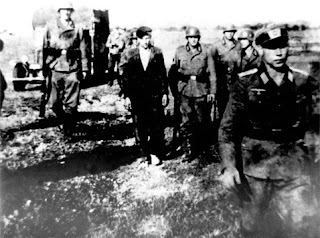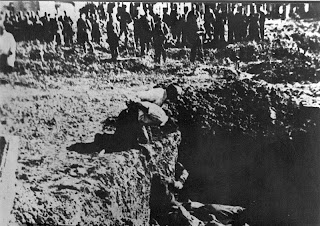In 1944, years after the liberation of Belgrade Unit 12 Vojvodina Corps, persistent battles had liberated most of eastern Srem, Ruma and all other settlements in the vicinity of *Sremska Mitrovica. In the western regions of Srem there were about 28,000 troops of the enemy army; these troops included the Germans, the Ustasha, nedićevaca and support members of the military. Also in the vicinity of Sremska Mitrovica, were a couple thousand members of the 13th SS Division. Headquarters at 12 Corps gave the orders to 11 Krajiska and 16 Vojvodina divisions to start the decimation of the enemy garrison in the city. Participating in that action were four artillery regiments and the 87 Mortars Guard Regiment of the Red Army.
Assault on the city began on 27 October, but was stopped at trenches excavated along the canal Sremska Mitrovica - Radinci. After three long days of fighting and assaults fighters from 16 Vojvodina Division replaced the exhausted members of the 11th Krajina Division on 30 October. Before the attack, division commander **Marco Perichin Kamenjar issued an order which, among other things, stated: "The staffs of our brigade must take seriously this mission of Sremska Mitrovica. Because there is no connection between our units that are liberating Sremska Mitrovica there is no success. Every one of our fighters, must proudly embark on this mission, as expected from 12 glorious divisions, to liberate the city. With the liberation of the city, last stronghold of the Ustashas and German bandits in the sector of Srem will be destroyed "
First Vojvodina Brigade occupied the positions near ***Jalija and the downtown, Fourth Brigade positions were near the main road and rail, and Second Vojvodina Brigade was the divisional reserve and security for the Russian artillery. General attack on the same day did not bring results, as the Germans fought tooth and nail. The action of 31 October was led by the local units and then the order was issued to 16 Division to move on sector ****Macva. While 21 Serbian division set off, in the early morning hours on 1 November to penetrate Mitrovica, occupied an entire city and continue the fight to Lacarak, on General channel. In five days of fighting between Mitrovica- Radinci-Bešenovo units, the 12 Corps had 1,200 troops who had died or were incapacitated, and the enemy had 1460 dead and wounded officers. Units of 16 division showed bravery and heroism in the fighting, and the headquarters proposed praise by the Supreme Commande for the 16 divisions.
The four-year occupation left deep scars in Mitrovica. In December of 1944 on 9292 living souls called Mirtovica home, however, by 1968 Mitrovica had 16,199 inhabitants. In remembrance of Sremska Mitrovica Liberation, a monument was erected in front of the Liberators of Mitrovica railway station.
*Sremska Mitrovica(
Sirmium), is a city and municipality located in the Vojvodina province, Serbia, on the left shore of the Sava river .. It is the administrative center of the Srem District of Serbia.Once and the capital of the Roman Empire during the Tetrarchy, the city was Referred to as the glorious mother of cities. [3] Likewise, ten Roman Emperors were born in or near this city , Emperors Herennius Etruscus (251) Hostilian (251), Traian Decius (249-251), Claudius II (268-270), Quintillus (270), Aurelian (270-275), Probus (276-282), Maximianus Herculius (285-310), Constantius II (337-361) and Gratian (367-383). Sremska Mitrovica is one of the oldest cities in Europe. Archaeologists have found a trace of organized human life dating from the 5000 BC onwards. Ionian jewelery dating to 500BC was excavated in the city. When the Romans conquered the city in the 1st century BC, Sirmium was already a settlement with a long tradition.
In the 1st century, Sirmium gained a status of a colony of the citizens of Rome, and became a very important military and strategic location in Pannonia province. The war expeditions of Roman emperors Trajan, Marcus Aurelius, and Claudius II, were prepared in Sirmium.
**Marko Pericin Kamenjar was born 24 March 1912, in the village Grgurevci near Sremska Mitrovica. He was from a poor peasant family. He finished elementary school in 1922 in his native village. He began working with National Liberation Movement from the first days of the uprising in 1941 and participated in the formation of the first armed groups in his hometown. Known as Rocky, he was one of the first of Fruška partizana. Rocky, during the war, faced many struggles and responsibilities as a combatant commander of the division. In April 1942 he was appointed as a Company Commander, within the year he was the battalion commander; March 1943, as well as, commanding Fruškogorskog and Srem detachments. With the formation of the First Brigade of Vojvodina, on 11 April, 1943, he was appointed its commander. Under his command, the brigade stood out in 1943, in the struggle for the defense of the free territory of Birca, the liberation of Srebrenica, as well as in fighting in Majevica around Brcko, Tuzla, in the Srem Grgurevci and bosutsko forests and also in eastern Bosnia.
In March 1944, Rocky was appointed commander of the 36th Vojvodina Division. Then in July, he took command of the 16th Vojvodina Division, a position he held until the end of the war. The division distinguished themselves in battles waged in eastern Bosnia and the liberation of Western Serbia and Belgrade; after, the unit helped save the Srem and entered into the composition of 12 Corps. As part of the Corps they were instrumental in liberating; Stara Pazova, Irig, Ruma, Sremska Mitrovica. Later, fighting found them, forcing the Danube, in Bačka and securing Opatovac and Mohovo, and in the final part Dravograda. Post war, Rocky was in command of the division and corps. He graduated from the Military Academy "funza" in the USSR, and then the higher military academy JNA in 1954, after which he performed various duties in a responsible JNA. He was Chief of Staff of Vojvodina and an active social and political worker. His military career ended with the rank of lieutenant general.
He received "Partisan Memorial” in 1941, and other high honors.
He was declared a national hero on 22 December 1951.
He died on 22 December 1982, in Novi Sad.
***Jalija(Turkish yali, strand, bank), is the oldest neighborhood in Sremska Mitrovica located just a couple min. from downtown.
****Macva, is a geographical region in Serbia, mostly situated in the northwest of Central Serbia. It is located in a fertile plain between the Sava and Drina rivers. The chief town of this region is Sabac. The modern Macva District of Serbia is named after the region, although the region of Macva include only northern part of this district. A small part of Northern Macva region is situated in the Autonomous Province of Vojvodina, in the Srem District.













